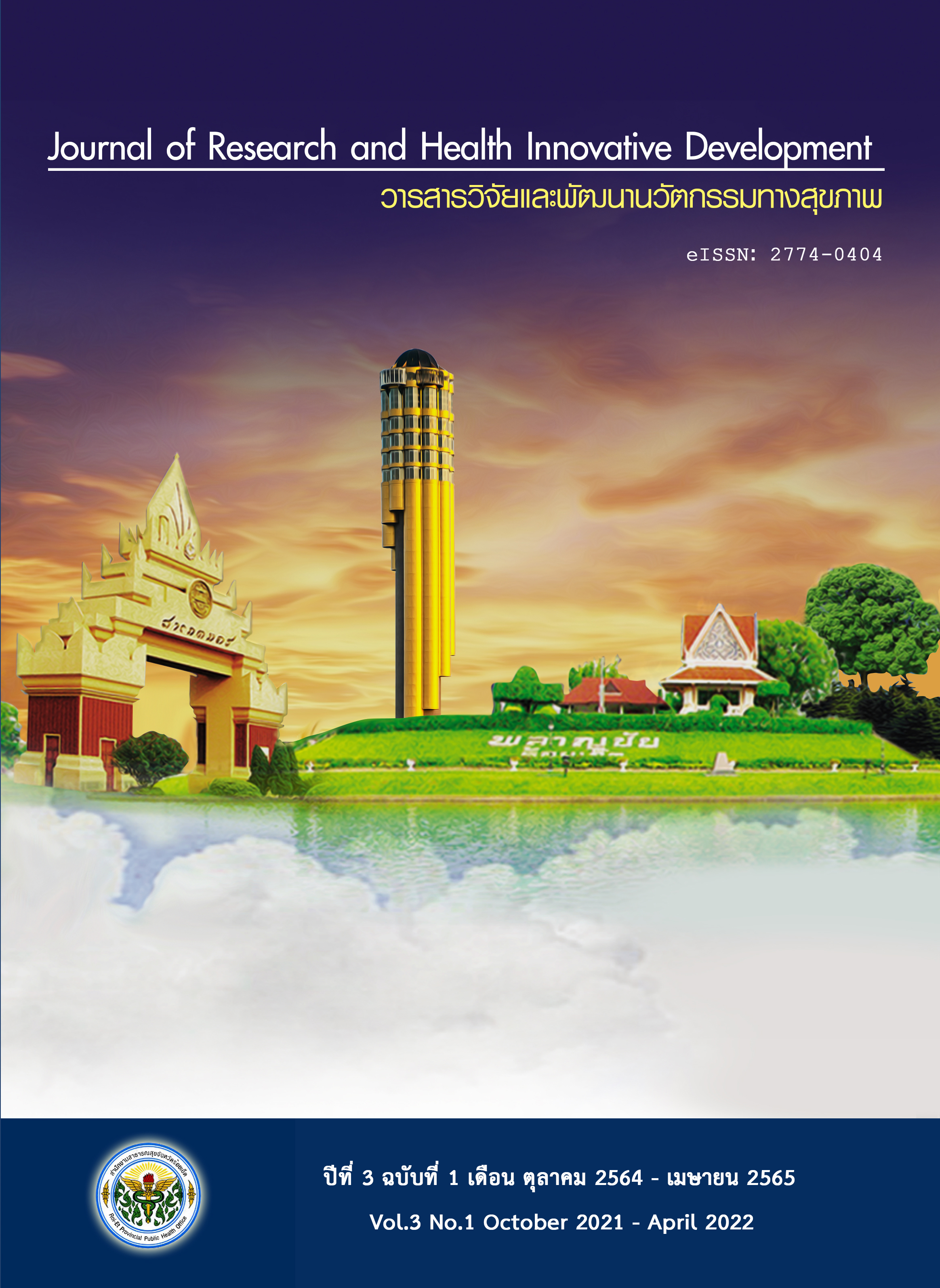ความชุกและปัจจัยที่มีความสัมพันธ์กับการใช้ยาสูดพ่นในผู้ป่วยเด็กโรคหืดที่มารับการรักษาที่โรงพยาบาลโพนทอง จังหวัดร้อยเอ็ด
คำสำคัญ:
หอบหืด, ยาสูดพ่นสเตียรอยด์, เทคนิคการใช้ยาสูดพ่นไม่ถูกต้องบทคัดย่อ
วัตถุประสงค์ : เพื่อศึกษาความชุกและปัจจัยที่มีความสัมพันธ์กับการใช้ยาสูดพ่นในผู้ป่วยเด็กโรคหืดที่มารับการรักษาที่โรงพยาบาลโพนทอง จังหวัดร้อยเอ็ด
รูปแบบการวิจัย : การวิจัยเชิงพรรณนาแบบภาคตัดขวาง (Cross - sectional study)
วัสดุและวิธีการวิจัย : กลุ่มตัวอย่างเป็นผู้ป่วยเด็กโรคหืดและผู้ดูแลที่มารับการรักษาด้วยยาสูดพ่นที่โรงพยาบาลโพนทอง ตั้งแต่ 1 ธันวาคม 2563 ถึง 31 พฤษภาคม 2564 จำนวน 96 รายที่มีคุณสมบัติตามเกณฑ์การคัดเข้า เก็บรวบรวมข้อมูลโดยใช้แบบสอบถาม ประเมินขั้นตอนการใช้ยาสูดพ่นของผู้ป่วยเด็กและหรือผู้ดูแล แสดงวิธีการใช้ยาสูดพ่นชนิด Metered Dose Inhaler (MDI) โดยใช้อุปกรณ์ Spacer หรือไม่ใช้อุปกรณ์ Spacer วิเคราะห์ข้อมูลโดยใช้สถิติเชิงพรรณนา
ผลการวิจัย : ผู้ป่วยเด็กโรคหืดทั้งหมด 96 ราย เป็นผู้ป่วยเด็กโรคหืดใช้ยาสูดพ่น MDI ร่วมกับอุปกรณ์ Spacer จำนวน 82 ราย และผู้ป่วยไม่ใช้อุปกรณ์ Spacer จำนวน 14 ราย พบมีความชุกการใช้ยาสูดพ่นที่ไม่ถูกต้อง จำนวน 59 ราย(61.4%) ในกลุ่มที่ใช้ Spacer พบขั้นตอนการนับจำนวนยาไม่ถูกต้องบ่อยที่สุด จำนวน 32 ราย (39.0%) ส่วนขั้นตอนที่ใช้ยาสูดพ่นชนิด MDIโดยไม่ใช้ร่วมกับอุปกรณ์ spacer ในขั้นตอนที่ไม่ถูกต้องมากที่สุดคือขั้นตอนการหายใจออกช้า 7 ราย (50.0%) การเขย่ากระบอกยาสูดพ่น 6 ราย (42.9%) และขั้นตอนการหายใจตอนกดยาสูดพ่น 4 ราย (28.6%) ส่วนปัจจัยที่เกี่ยวข้องกับการใช้ยาสูดพ่นไม่ถูกต้อง คือผู้ดูแลหลักที่ไม่ใช่มารดา ผู้ป่วยโรคหอบหืดที่เคยได้รับการนอนโรงพยาบาลด้วยโรคหอบหืดกำเริบมีความเสี่ยงที่ใช้ยาสูดพ่นไม่ถูกต้อง ผู้ป่วยและผู้ดูแลไม่เข้าใจคำแนะนำหรือการสอนเกี่ยวกับการใช้ยาสูดพ่นจากบุคลากรในโรงพยาบาลมีโอกาสใช้ยาสูดพ่นไม่ถูกต้อง
สรุปและข้อเสนอแนะ : ผลการศึกษาครั้งนี้ชี้ให้เห็นว่าวิธีการสูดพ่นยาที่ไม่ถูกต้องมีผลต่อการนอนโรงพยาบาลด้วยโรคหืดกำเริบ
เอกสารอ้างอิง
Masoli M, Fabian D, Holt S, Beasley R, Program GIfA. The global burden of asthma: executive summary of the GINA Dissemination Committee report. Allergy. 2004;59(5):469-78.
Trakultivakorn M, Sangsupawanich P, Vichyanond P. Time trends of the prevalence of asthma, rhinitis and eczema in Thai children–ISAAC (International Study of Asthma and Allergies in Childhood) Phase Three. Journal of asthma. 2007;44(8):609-11.
Sritipsukho P, Viriyaudomsir O. Health-related quality of life in Thai children with allergic respiratory diseases. J Med Assoc Thai. 2015;98(5):457-63.
Ban G-Y, Ye Y-M, Lee Y, Kim J-E, Nam Y-H, Lee S-K, et al. Predictors of asthma control by stepwise treatment in elderly asthmatic patients. Journal of Korean medical science. 2015;30(8):1042-7.
Makhinova T, Barner JC, Richards KM, Rascati KL. Asthma controller medication adherence, risk of exacerbation, and use of rescue agents among Texas Medicaid patients with persistent asthma. Journal of managed care & specialty pharmacy. 2015;21(12):1124-32.
Puranik S, Forno E, Bush A, Celedón JC. Predicting severe asthma exacerbations in children. American journal of respiratory and critical care medicine. 2017;195(7):854-9.
Melani AS, Bonavia M, Cilenti V, Cinti C, Lodi M, Martucci P, et al. Inhaler mishandling remains common in real life and is associated with reduced disease control. Respiratory medicine. 2011;105(6):930-8.
Deerojanawong J, na Sakolnakorn VP, Prapphal N, Hanrutakorn C, Sritippayawan S. Evaluation of metered-dose inhaler administration technique among asthmatic children and their caregivers in Thailand. Asian Pac J Allergy Immunol. 2009;27(2-3):87-93.
Kamps AW, van Ewijk B, Roorda RJ, Brand PL. Poor inhalation technique, even after inhalation instructions, in children with asthma. Pediatric pulmonology. 2000;29(1):39-42.
Sanchis J, Gich I, Pedersen S, Team ADMI. Systematic review of errors in inhaler use: has patient technique improved over time? Chest. 2016;150(2):394-406.
Topal E, Celiksoy MH, Catal F, Sinanoglu MS, Karakoc HT, Sancak R, et al. Assessment of skills using a spacer device for a metered-dose inhaler and related independent predictive factors in caregivers of asthmatic preschool children. Int Forum Allergy Rhinol. 2016; 6: 130-4.
Zhao J, Shen K, Xiang L, Zhang G, Xie M, Bai J, et al. The knowledge, attitudes and practices of parents of children with asthma in 29 cities of China: a multi-center study. BMC pediatrics. 2013;13(1):1-6.
Fink JB, Rubin BK. Problems with inhaler use: a call for improved clinician and patient education. Respiratory care. 2005;50(10):1360-75.
Gillette C, Rockich-Winston N, Kuhn J. Inhaler Technique in Children With Asthma: A Systematic Review. Acad Pediatr 2016; 16 (7): 605–15. DOI: 10.1016/j. acap. 2016.04. 006.
Initiative for Asthma (GINA). Global Strategy for Asthma Management and Prevention. Ontario, Canada: GINA; 2015.
Price D, Bosnic-Anticevich S, Briggs A, Chrystyn H, Rand C, Scheuch G, et al. Inhaler competence in asthma: common errors, barriers to use and recommended solutions. Respiratory medicine. 2013;107(1):37-46.
Capanoglu M, Dibek Misirlioglu E, Toyran M, Civelek E, Kocabas CN. Evaluation of inhaler technique, adherence to therapy and their effect on disease control among children with asthma using metered dose or dry powder inhalers. Journal of Asthma. 2015;52(8):838-45
Reznik M, Silver EJ, Cao Y. Evaluation of MDI-spacer utilization and technique in caregivers of urban minority children with persistent asthma. Journal of Asthma. 2014;51(2):149-54.
Shaw N, Le Souëf P, Turkovic L, McCahon L, Kicic A, Sly PD, et al. Pressurised metered dose inhaler-spacer technique in young children improves with video instruction. European journal of pediatrics. 2016;175(7):1007-12.
ดาวน์โหลด
เผยแพร่แล้ว
รูปแบบการอ้างอิง
ฉบับ
ประเภทบทความ
สัญญาอนุญาต
บทความที่ได้รับการตีพิมพ์เป็นลิขสิทธิ์ของ สำนักงานสาธารณสุขจังหวัดร้อยเอ็ด
บทความที่ลงตีพิมพ์ในวารสารวิจัย และพัฒนานวัตกรรมทางสุขภาพ สํานักงานสาธารณสุขจังหวัดร้อยเอ็ด ถือเป็น ผลงานวิชาการ งานวิจัย วิเคราะห์ ตลอดจนเป็นความเห็นส่วนตัวของผู้ประพันธ์ กองบรรณาธิการไม่จําเป็นต้องเห็น ด้วยเสมอไป และผู้ประพันธ์จะต้องรับผิดชอบต่อบทความของตนเอง



